
Trillium is a genus of about fifty flowering plant species in the family Melanthiaceae. Trillium species are native to temperate regions of North America and Asia, with the greatest diversity of species found in the southern Appalachian Mountains in the southeastern United States.
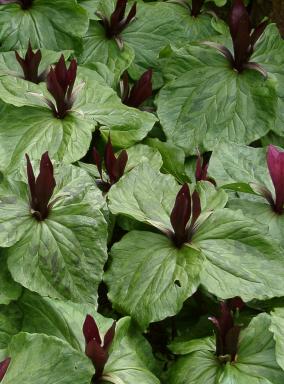
Trillium chloropetalum, also known as giant trillium, giant wakerobin, or common trillium, is a species of flowering plant in the family Melanthiaceae. It is endemic to the western U.S. state of California, being especially frequent in and around the San Francisco Bay Area.
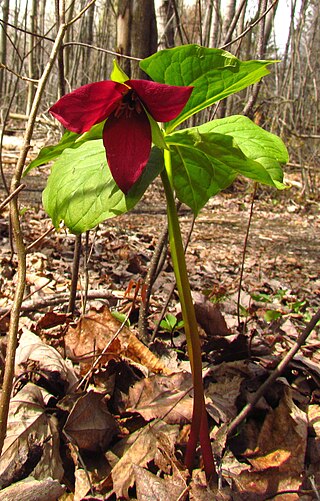
Trillium erectum, the red trillium, also known as wake robin, purple trillium, bethroot, or stinking benjamin, is a species of flowering plant in the family Melanthiaceae. The plant takes its common name "wake robin" by analogy with the European robin, which has a red breast heralding spring. Likewise Trillium erectum is a spring ephemeral plant whose life-cycle is synchronized with that of the forests in which it lives. It is native to the eastern United States and eastern Canada from northern Georgia to Quebec and New Brunswick.
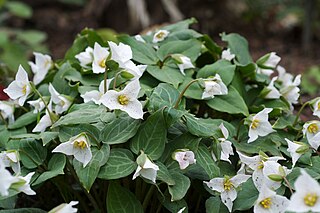
Pseudotrillium is a monotypic genus of flowering plant in the family Melanthiaceae. Its sole species, Pseudotrillium rivale, is commonly known as the brook wakerobin. It is endemic to the Siskiyou Mountains of southern Oregon and northern California. The Latin specific epithet rivale means “growing by streams”, with reference to a preferred habitat.
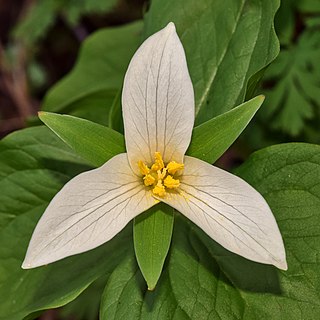
Trillium ovatum, the Pacific trillium, also known as the western wakerobin, western white trillium, or western trillium, is a species of flowering plant in the family Melanthiaceae. It is found in western North America, from southern British Columbia and the tip of southwestern Alberta to central California, east to Idaho and western Montana. There is an isolated population in northern Colorado and southern Wyoming.

Trillium discolor, the mottled wakerobin, pale yellow trillium, or small yellow toadshade, is a species of flowering plant in the family Melanthiaceae. It is native to areas of the Savannah River drainage system of Georgia, North Carolina and South Carolina such as Steven's Creek Heritage Preserve and Lake Keowee. It is found along moist stream banks in upland woods, on acidic to basic soils.

Trillium cuneatum, the little sweet betsy, also known as whip-poor-will flower, large toadshade, purple toadshade, and bloody butcher, is a species of flowering plant in the family Melanthiaceae. It is a member of the Trillium cuneatum complex, a subgroup of the sessile-flowered trilliums. It is native to the southeastern United States but is especially common in a region that extends from southern Kentucky through central Tennessee to northern Alabama. In its native habitat, this perennial plant flowers from early March to late April. It is the largest of the eastern sessile-flowered trilliums.
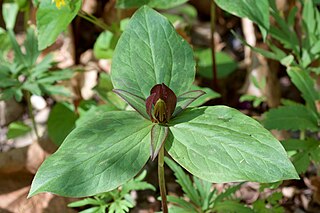
Trillium sessile is a species of flowering plant in the bunchflower family Melanthiaceae. The specific epithet sessile means "attached without a distinct stalk", an apparent reference to its stalkless flower. It is commonly known as toadshade or toad trillium. It is also called sessile trillium or sessile-flowered wake-robin, however it is not the only member of the genus with a sessile flower.

Trillium decipiens, also known as Chattahoochee River wakerobin or deceiving trillium, is a spring-flowering perennial plant. It occurs mostly near the Chattahoochee River in Alabama, Florida and Georgia. Scattered populations are found elsewhere in these three states, all within the Atlantic Coastal Plain or Gulf Coastal Plain. Rich deciduous woods of bluffs, ravines, and alluvial land provide its most favored habitat.

Trillium lancifolium, the lanceleaf wakerobin, lance-leaved trillium, or narrow-leaved trillium, is a species of plants native to the southeastern United States. It is known to occur in Alabama, Florida, Georgia, Mississippi, South Carolina, and Tennessee. The species is imperiled in Alabama and Florida, and critically imperiled in South Carolina and Tennessee.
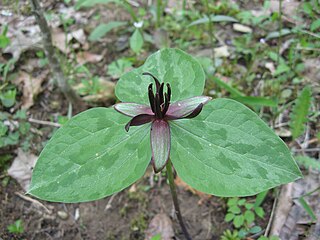
Trillium stamineum, the twisted trillium, also known as the Blue Ridge wakerobin, is a species of flowering plant in the family Melanthiaceae. It is native to the southeastern United States, in Alabama, Mississippi and Tennessee. Its natural habitat is calcareous woodlands.

Trillium sulcatum is a species of flowering plant in the bunchflower family Melanthiaceae. It is a member of the Erectum group, a group of species typified by Trillium erectum. The specific name sulcatum means "furrowed, grooved, or sulcate", which describes the tips of the sepals. It is most abundant on the Cumberland Plateau in central Tennessee and eastern Kentucky where it blooms in April and May. The species is commonly known as the southern red trillium or furrowed wakerobin.
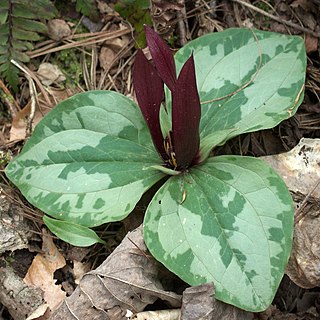
Trillium decumbens, also known as the decumbent trillium or trailing wakerobin, is a species of flowering plant in the bunchflower family (Melanthiaceae). It is native to the southeastern United States, specifically Tennessee, Georgia, and Alabama, where it grows in mature deciduous woodlands or on open rocky wooded slopes.

Trillium pusillum is a species of flowering plant in the family Melanthiaceae known by the common names dwarf trillium, least trillium and dwarf wakerobin. It is native to the southeastern and south-central United States from Oklahoma to Maryland.

Trillium albidum is a species of flowering plant in the bunchflower family Melanthiaceae. It is the only trillium characterized by a stalkless white flower. The species is endemic to the western United States, ranging from central California through Oregon to southwestern Washington. In the San Francisco Bay Area, it is often confused with a white-flowered form of Trillium chloropetalum. In northern Oregon and southwestern Washington, it has a smaller, less conspicuous flower.

Trillium petiolatum, the Idaho trillium, also known as the long-petioled trillium or round-leaved trillium, is a species of flowering plant in the family Melanthiaceae. It is native to the northwestern United States, in Idaho, Oregon, and Washington. The type specimen for this species was gathered by Meriwether Lewis in 1806 along the Clearwater River during the return trip of the Lewis and Clark Expedition.
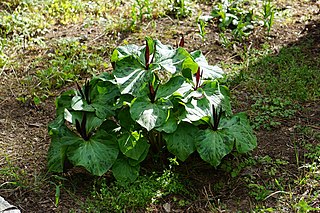
Trillium angustipetalum, with the common name is narrowpetal wakerobin, is a species of Trillium, plants which may be included within the Liliaceae or the newer family Melanthiaceae.
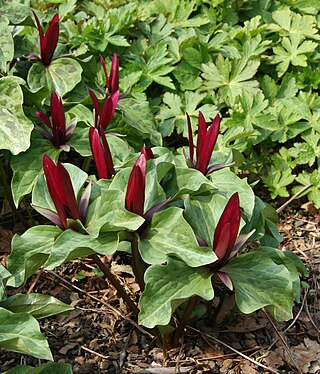
Trillium kurabayashii is a species of flowering plant in the bunchflower family Melanthiaceae. The species is endemic to the western United States, occurring in extreme southwestern Oregon, northwestern California, and the Sierra Nevada of northern California. It was first described by John Daniel Freeman in 1975. The specific epithet kurabayashii honors Masataka Kurabayashi, a Japanese cytologist and population geneticist who first postulated the taxon’s existence. It is commonly known as the giant purple wakerobin, a reference to its conspicuously large, dark purple-red flower, one of the largest of any sessile-flowered trillium.
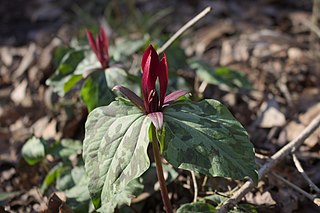
Trillium maculatum, the spotted wakerobin or spotted trillium, is a species of flowering plant in the family Melanthiaceae. It is a member of the Trillium cuneatum complex, a closely-related group of sessile-flowered trilliums. The species is endemic to the southeastern United States, ranging across Alabama, Georgia, South Carolina, and northern Florida.
Trillium tennesseense, the Tennessee trillium, is a species of flowering plant in the family Melanthiaceae. It is found exclusively within two counties in northeastern Tennessee. Due to its limited range, it is designated as a critically imperiled species.




















